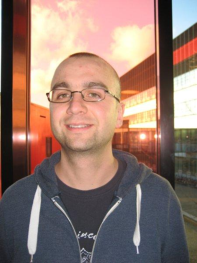Understanding microstructural properties of perovskite ceramics through their wet-chemical synthesis.
Promotion date: 15. December 2011
Promotor: Prof.dr. ir. André ten Elshof
Assistant promotor: Prof. dr. ing. Dave Blank
| The thesis comprises of seven full research chapters on the morphology, properties and processing of sol-gel precursor systems of barium titanate and lead zirconate titanate thin films and powders. In all the considered problems, the synthesis leading to nano-sized perovskite ceramics constitutes the main research theme. In particular it was the primary interest to investigate early processing stages when only amorphous wet-chemical precursors were present. For this purpose a number of techniques was employed e.g. small angle x-ray scattering or electron energy loss spectroscopy. By these means sol and gel evolution under constant composition and under drying was characterized for the first time. It is stated that the complexity of sol-gel processing does not lie in its “hardware” aspects, but in its subtle chemistry. postulated is that only profound understanding, or at least a will to comprehend some of crucial aspects, can lead to mass-production of sol-gel derived ceramics of expected properties and performance. |
Why is it important to investigate these aspects of synthesis leading to nano-sized perovskite ceramics?
Barium titanate (BTO) is used as a high-k dielectric material in multi-layer ceramic capacitors. Similarly lead zirconate titanate (PZT) is applied among others in actuators and sensors. Wet-chemical methods based on sol-gel reactions can be applied to make both BTO and PZT. Knowledge of the size, shape and kinetics of primary sol-gel derived oligomeric nanostructures in solution and upon drying is crucial to optimize the processing of functional oxide thin films from these solutions.
I focused on the synthesis and characterization of precursors using wet-chemical techniques. It is commonly assumed that these methods provide a near-molecular-level of mixing of the precursor components. In theory that should provide homogenous and stable precursors that can be used to obtain high-quality electroceramics.
Nevertheless, this is not always the case. Early processing stages are known to influence the microstructure and physical properties of the resulting oxide films or powders. The actual reasons behind are often difficult to be clearly identified.
Hence, there is a large gap in understanding of the sol-gel processes leading to the perovskite oxides. By investigating these aspects closely, sol-gel processing can be better understood. This is the only way to control the expected properties and performance parameters for designing nano-scale devices in the future.
Was your research fundamental or also application oriented?
Initially the project was industry-oriented and was driven by the knowledge questions from the partner companies. It had occurred that a more fundamental approach was necessary to answer all the pending questions. It was caused by the fact that the benefit of reaching the nano-size was not exactly straightforwardly obvious in the case of e.g. barium titanate and other perovskites, due to the degradation of the physical properties of the materials.
After this research, I am sure that good fabrication at a nano-level is possible if designers are willing to deal with the materials parameters in a creative manner. One has to accept that these materials act differently at a small scale.
Were there some special moments during your thesis project that you recall?
There were quite a few, I might say. Especially the results from the BM-26B at DUBBLE of the synchrotron in Grenoble (ESRF) led to new insights, because we were able to observe phenomena as they were happening on a scale at which we were ‘blind’ before. It was an extraordinary experience to be able to use this unique equipment. In my opinion synchrotrons and other high-tech devices should be open and accessible for more scientists, all over the world.
Did you manage to write some nice publications?
I either wrote or co-authored ten papers that were published so far (and more is coming), for example in: Journal of Chemistry C, Langmuir and Journal of the American Ceramic Society. Also I was a speaker or had a poster presentation at nearly twenty conferences in Europe and one time in Japan.
How did you develop as a scientist and researcher in this period?
I can oversee the whole of the research project much better and faster now. I enjoy focusing on an issue more and knowing in a quick way the direction of research I can choose best.
What are your future plans?
I would like to stay in academic research, most likely in the Netherlands, as I like the freedom of research. Perhaps in a later stage of my life, I will start working in industry.
What, in your opinion, is important for Mesa+ to stay successful in future?
Collaborating with other groups was bringing me a lot of new insights and was very inspiring to me, for example with the research of Catalytic Processes and Materials group.
Different groups can work more theme-oriented, I believe, sharing different expertise and bringing them together.
Instead of organizing conferences, new ways of sharing expertise could be investigated and simply tried out, just to learn what researchers are working on, which devices and equipment they use to reach their goals.
Perhaps PhD students can work on organizational networks on their own, independent of the leaders of the groups. This can lead to new mini research projects. It would lead to many interesting new publications, I am sure. Many PhD’s have side-projects, which are very promising. Finding ways of collaboration is often difficult as Mesa+ is a pretty large institution.

